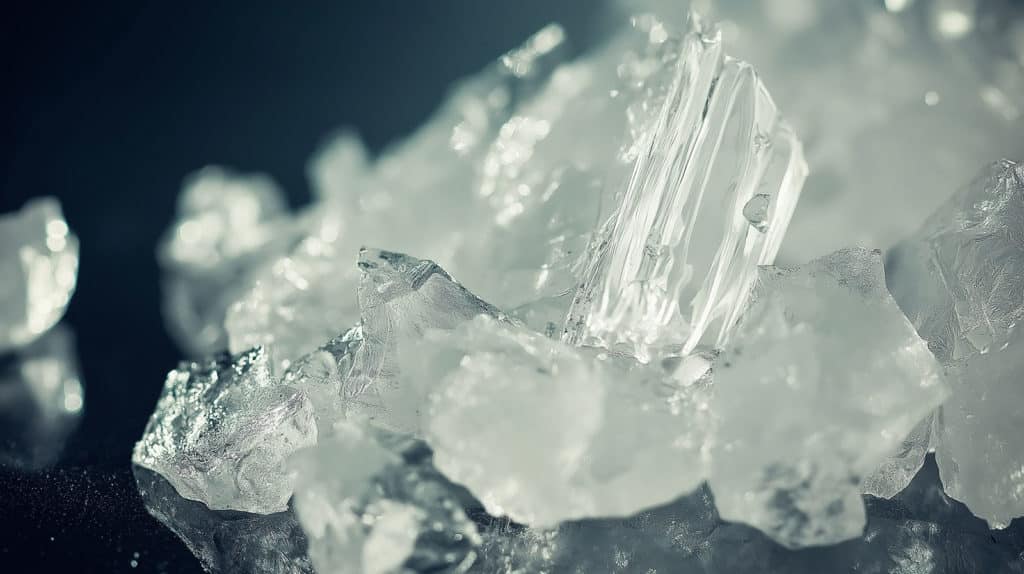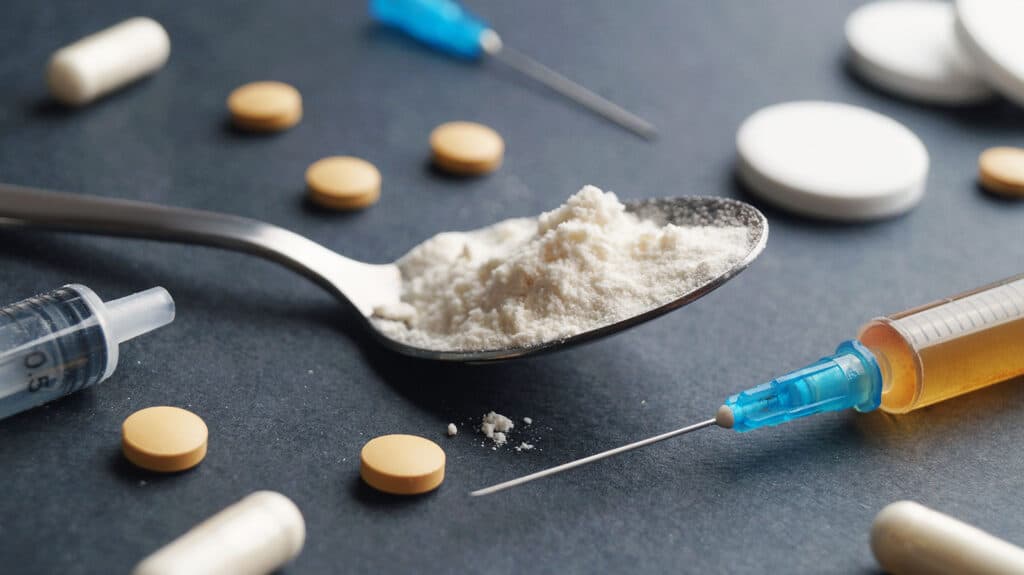Methamphetamine is a dangerous, highly addictive drug that stays active and unchanged in the body for extended periods.
Of particular concern is its growing role in the country’s overdose epidemic. Reports show more people are using meth with illicit fentanyl. This deadly mix makes two risky substances even more lethal.
So, how can you tell if someone is on meth?
Below, we’ll discuss all the physical, psychological, and behavioral symptoms to watch for.

Table of Contents
Physical Signs of Meth Use
Methamphetamine use takes a serious toll on the body. The physical effects are often visible, and the damage only worsens over time.
In many cases, you can tell someone is using just by eyeballing them. Let’s take a closer look at these physical symptoms:
1. Extreme Weight Loss
Meth is a potent appetite suppressant, making users feel little to no hunger. As a result, they can lose weight pretty quickly.
And it’s not just a few pounds. It can be a drastic drop in body weight within a short period. Once malnutrition sets in, the body weakens, putting a person at risk for many medical conditions.
2. Skin Sores
Meth users can feel bugs crawling under their skin, a sensation known as formication. This is a common type of tactile hallucination.
Desperate for relief, people scratch and pick at their skin almost uncontrollably. Often, they don’t realize how much damage they’re doing.
Because of this, meth users develop sores that don’t easily heal. Poor hygiene and a weakened immune system also make them more prone to skin infections.
3. Dental Problems
“Meth mouth” is another common side effect of meth abuse. Teeth may become stained, broken, rotting, and in some cases, destroyed beyond fixing.
It starts with a dry mouth. Meth is dehydrating, but the toxic chemicals in it make things so much worse.
You’ll be shocked to learn that meth contains industrial substances like battery acid, paint thinner, drain cleaner, and fertilizer. All these are highly drying and corrosive.
Without adequate saliva to protect against harmful bacteria, tooth decay and gum disease can rapidly develop.
On top of that, meth makes users anxious and jittery, leading to teeth grinding (bruxism). This grinding wears down tooth enamel, weakening and fracturing teeth over time.
4. Increased Body Temperature and Sweating
Meth cranks up the central nervous system, overstimulating the hypothalamus (the thermo-regulation center of the brain) and causing the body to overheat.
At the same time, meth constricts blood vessels, trapping heat inside. In response, users sweat profusely to cool down. That’s why it’s not uncommon for meth users to also have body odor.
5. Dilated Pupils
Meth triggers a rush of norepinephrine, the body’s “fight-or-flight” chemical. One of its effects is stimulating the muscles that make the pupils expand.
Simultaneously, meth blocks the brain from reabsorbing norepinephrine, keeping it active for longer. This means the pupils remain dilated for an extended period, even in bright light.

Behavioral and Psychological Signs of Meth Use
Meth doesn’t just ravage the body. It also profoundly impacts a person’s mental health and well-being.
People using crystal meth often show noticeable psychological and behavioral changes that can turn their daily lives upside down.
Here are the signs to be aware of:
1. Tweaking
Tweaking is a state of extreme agitation and paranoia that can occur after a meth binge (when someone takes small doses every few hours for days to keep the high going). It’s typical in substance use disorders (SUD) of all kinds.
Someone in this state may appear highly anxious, restless, and irritable. They may engage in repetitive behaviors, such as fidgeting, picking at their skin, or small, twitchy movements.
Ahead are more extreme manifestations of tweaking.
2. Mood Swings
Meth use leads to extreme and unpredictable emotional swings. Your emotions can quickly switch from euphoria and invincibility to irritability and deep depression within moments.
The abundance of dopamine which regulates pleasure and motivation leads to these occurrences.
Users experience exhaustion, emptiness, and erratic behavior when dopamine levels plummet after the high subsides.
3. Insomnia
Meth causes sleep disturbances because it overloads the brain with dopamine along with other stimulating substances.
Users remain alert and stimulated for extended periods, which can last from hours to multiple days.
The brain struggles to restore normal sleep-wake cycles after the stimulant’s effects fade away. Users often report restless energy alongside anxiety and hallucinations.
4. Memory Loss
Meth messes up the brain’s ability to store and process information. Users forget conversations, misplace things, or lose track of what they’re doing. They also have trouble recalling important details from past experiences.
Research shows that meth causes lasting damage to brain cells and disrupts the way neurons form new connections, explaining the memory loss.
5. Hyperactivity
A person who has consumed methamphetamine experiences extreme levels of energy. Users may appear overly excited, hyper-focused, or unable to sit still. Their speech may also become rapid and scattered, jumping from topic to topic.
Some people fixate on meaningless tasks, like taking apart and reassembling objects, counting random items, or pacing nonstop. Others may clean obsessively or spend hours absorbed in video games or other activities.
6. Psychosis
Even people without mental illness history can experience meth-induced psychosis. They may experience intense hallucinations, paranoia, and delusions.
Some believe they’re being watched or followed or conjure up complex conspiracy theories that make no sense at all.
Even more worrying is how these symptoms can linger long after the drug has worn off, sometimes for days, weeks, or even longer with heavy use.
7. Violent Behavior
One of the most terrifying effects of meth addiction is how it changes someone’s personality.
Imagine someone you know, maybe a kind and gentle person, suddenly displaying violent behavior.
These sudden outbursts of anger and violence create a tense, scary atmosphere for everyone, including the user themselves.
It’s not at all surprising when you consider what meth does to the brain. Paranoia, sleep deprivation, and chemical imbalances can really turn anyone into someone completely unrecognizable.

Health Problems Caused by Meth Abuse
The danger of meth is that, unlike opioids, there’s no fast-acting antidote like Narcan to reverse an overdose. That’s quite scary, especially given how many people are using meth today.
After accidental overdose, cardiovascular diseases are the second most common cause of death among chronic meth users.
Meth puts immense stress on the heart by narrowing blood vessels, raising blood pressure, and significantly increasing heart rate. Left unchecked, this can lead to life-threatening emergencies like stroke and heart attack.
Getting Help: Meth Addiction Treatment
No FDA-approved medications currently exist to treat meth addiction specifically. The good news is, effective treatment options are still available.
- Detox: The first step is clearing meth from the body in a safe, supervised setting. Withdrawal symptoms and cravings can be intense, so medical support is often necessary. Detox can take weeks to months, depending on the severity of the case.
- Therapy: Behavioral therapies, such as cognitive-behavioral therapy (CBT) and contingency management, can address the psychological aspects of addiction.
- Inpatient and Outpatient Rehab: Treatment centers offer structured programs, including therapy, counseling, and family education, to aid recovery.
- Support Groups: Groups like Narcotics Anonymous (NA) provide ongoing support from people who have battled addiction and understand the struggle firsthand.
Recovery is hard, but with the right help and support, it’s not impossible.
Final Thoughts
Recognizing the signs of methamphetamine addiction in someone you care about is often the first step toward recovery. The sooner intervention happens, the better the chances of preventing long-term effects.
It’s okay to feel uncertain about what to do next; that’s exactly why we’re here. At Illinois Recovery Center, our team of professionals can create personalized treatment programs that address the complex nature of meth addiction.
Don’t wait. Call us today to get your loved one the professional help they need.
Resources:
- https://www.usatoday.com/story/news/health/2024/02/21/methamphetamine-plays-increasing-role-in-addiction-crisis/72661430007
- https://www.oregon.gov/oha/ph/healthyenvironments/healthyneighborhoods/clandestinedruglabs/pages/chemicals.aspx
- https://pmc.ncbi.nlm.nih.gov/articles/PMC3831527
- https://www.ahajournals.org/doi/10.1161/ATVBAHA.119.312461



